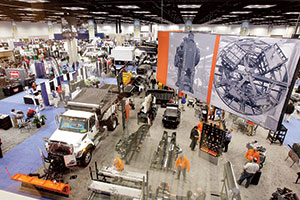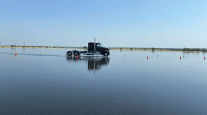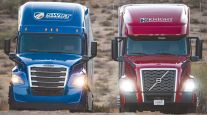Replacement of Older Units Drives Growth Of Medium-Duty Vehicle Sales, Analysts Say

This story appears in the March 2 print edition of Transport Topics.
Medium-duty trucks sales reached their highest level in years during 2014, boosted by replacement activity among large-scale buyers who are cycling older units out of their fleets. But while the growth is a sign that commercial buyers see economic opportunity ahead, the piecemeal approach to acquisitions will hold the industry back from returning to previous heights, industry experts said.
“The growth in sales is good, but the sales were for replacement trucks, not expansion,” said Stephen Latin-Kasper, director of market data and research for the National Truck Equipment Association, which is hosting its annual Work Truck Show in Indianapolis this week. “And, [2015] medium-duty sales will increase over 2014 numbers, but the growth is not accelerating as it is expected to do in the Class 8 market,” he said.
Medium-duty truck buyers purchased more than 186,000 chassis last year, powering double-digit retail sales growth across Classes 4-7, the best showing in seven years. Even so, total sales were far short of the 260,000 recorded at the sector’s peak in 2006 and did little to reduce the average age of a graying national fleet, where some units have been on the road for 20 years and more.
In 2007, the average age of Class 4 vehicles on the road was 10 years. By 2014, that had risen to 13 years, according to Latin-Kasper. The average age of the Class 6 group is older still, up to 21 years, from 18 in 2007. One exception to this aging trend is in Class 5, where the average age improved to 12 years from 13 years in 2007, he noted.
A key reason businesses held on to vehicles so long was the 2008 recession, which hit the medium-duty sector extremely hard, said Steve Tam, vice president of the commercial vehicle sector with ACT Research in Columbus, Indiana.
“The recession was deep, and it’s taking a long time to come out of it,” he said. “A lot of small business owners . . . are feeling good and confidant, but still, that’s not making up for lost time.”
Gary Meteer, director of commercial solutions with IHS Automotive, pegged the average age of combined medium and heavy trucks (Classes 4-8) at 14.7 years in 2014, up from 12.5 in 2007.
“The current vehicle population and the amount of work to do suggest that it’s still a shrinking population of medium-duty trucks,” ACT’s Tam said. “It won’t be until the end of 2016 [that] they start growing the vehicle population again.”
And studying the trends of an aging fleet is more than just an academic exercise for analysts and economists, Latin-Kasper noted, pointing out that money spent repairing older trucks is money that’s not being invested in expansion.
Right now, it’s larger businesses — those with 500 or more trucks — that are making that investment, Meteer said.
“Big fleets are getting back in the market at levels we haven’t seen since 2006 and 2007,” he said. “Over the past few years, large fleets focused on managing their operations and keeping tight control on their finances. They were happier sending new business off to a third party rather than incur the costs of buying new trucks and adding drivers. Now, they’re adding to their fleet more than before, and that’s fueling a lot of the growth.”
Upfitters may be having the best of both words, as higher retail sales mean new business while the old trucks on the road still need to be repaired.
Buzz Tabone, vice president of sales for Zoresco Equipment Co., a multiline upfitter based in Turtle Creek, Pennsylvania, said that 2014 was a “good, solid” year and he expects business in 2015 to be stronger.
“I see both growth and replacement from our customers,” he said. “It was a deep recession, and there are still some lingering effects — still somewhat of a pent-up demand. Some customers are gradually replacing their units; but we’re also seeing new employee growth and companies are adding vehicles to handle the business.
“One thing that is changing is the indicator customers use to judge when to replace vehicles. In the past, fleets would rely on rigid standards, such as the miles per year, the truck’s age or other indicators. Now, they are shifting to more financial-based indicators; they’re looking at the performance of the company, and that factors into the decision.”
Steven Sill, president of Aspen Equipment in Bloomington, Minnesota, said business was up in 2014, and he expects that to continue.
“For the first time, I remember we were turning away substantial business because we couldn’t handle it,” he said. “We’re expecting about 10% growth in 2015.”
Sill said he has seen improvement in several areas, including construction, railroad support, highway maintenance and, notably, government and municipal business, the latter a result of new housing and the accompanying tax revenue that flows into municipal budgets.
“Typically, we take the [municipal] orders in July for work in October, but last year we took the orders in April and we were sold out by September,” he said. “We’re also selling to a lot of fleets in the utility market for line work, wind-power construction and the like. Railroad work is holding up well, too.”
The trucks being purchased for these and other applications may look different; some medium-duty trucks are stronger and more capable than the units that were available in buyers’ last purchasing cycle, which permits them to step down a class.
“We’re seeing customers looking to downsize to a lower class,” said Dave Sowers, head of commercial vehicle marketing for Ram Truck. “In the retail segment, customers are buying 2500s to replace their older 3500 because the 2500 is more capable.”
Todd Bloom, president of Mitsubishi Fuso Trucks of America, noted that because the medium-duty sector includes so many vocational markets, the equipment needs are as varied as the applications.
“Because of this, the array of available options has been increasing,” he said. “Fewer trucks are sold as standard, unchangeable models.”
Mary Aufdemberg, director of product marketing for Freightliner Trucks, said in response to an e-mail that the Daimler division has seen growth in every medium-duty segment it tracks.
“In the past two years, we’ve seen an increase of more than 10 percentage points in specialized hauling, utility, municipal business, leasing, and pickup
and delivery applications,” she said. “During that same timeframe, we also increased in medium-duty construction by 5 percent points.”
It doesn’t appear that the expected growth in sales this year will appreciably slow the aging process of the medium-duty fleet.
Nevertheless, the market is growing, said ACT’s Tam, just not at breakneck speed.
“It’s not sky rocketing, we’re not seeing the sexy returns as heavy-duty,” he said, “but it’s a very steady and stable market.”




